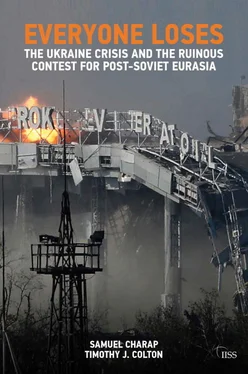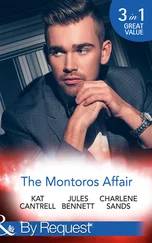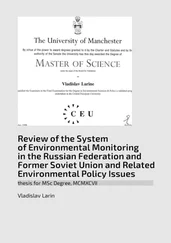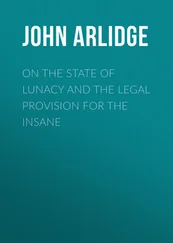Russia continued playing the military card. The border-area drills were transformed into a sustained build-up of a strike force estimated at the better part of 50,000 strong. Russia could now invade its neighbour at a moment’s notice. It also sent more sophisticated weapons across the border. Anti-aircraft systems proved particularly lethal, leading to the grounding of the Ukrainian air force after several planes were shot down. Russia was resorting to increasingly destructive means to get its way.
Kremlin statements telegraphed an interest in sowing chaos. In mid-April, Putin declared, ‘We believe that we ought to do everything we can to help these people [in southern and eastern Ukraine] defend their rights and independently determine their fate…. The essential issue is how to ensure the legitimate rights and interests of ethnic Russians and Russian speakers in the south and east of Ukraine.’ He ‘reminded’ the audience that the Donbas and other oblasts were part of the Russian Empire, and ‘were given to Ukraine in the 1920s by the Soviet government. Why they did this, God only knows.’ [41] ‘Pryamaya liniya s Vladimirom Putinym’, 17 April 2014, http://kremlin.ru/events/president/news/20796 . As it happens, his claim about the Soviet government’s decisions in the 1920s was false.
Russia was unsubtly egging on anti-Maidan sentiment and encouraging destabilisation. Given the implications of Putin’s questioning of ownership rights over much of Ukraine’s south and east, the build-up on the border, and the lightning-fast evolution of the Crimea operation, neither Kyiv nor Western capitals could have any degree of certainty about Moscow’s next move.
In the meantime, the US and the EU stepped up support for the newly installed authorities in Kyiv. Days after the revolution, NATO agreed on measures to bolster its partnership with Ukraine. Obama received Yatsenyuk at the White House, a first for a Ukrainian prime minister, and pledged backing for his government, including a US$1bn loan guarantee and nearly US$200m in aid. Vice President Biden soon flew to Kyiv, the first of several visits, to reinforce US support for Ukraine as the government mounted the counter-attack against the separatists.
The EU granted Ukraine preferential access to its markets, a unilateral implementation of the EU’s commitments to lower tariffs under the DCFTA. By removing 95% of EU customs duties on imports of industrial goods from Ukraine and all tariffs on agricultural produce, Brussels was effectively granting hundreds of millions of euros of assistance. The EU also provided significant transfers to the Ukrainian government budget. By the end of June, Kyiv had signed the AA. Most importantly, the International Monetary Fund (IMF) approved US$17bn in loans for Ukraine. [42] ‘Press Release: IMF Executive Board Approves 2-Year US$17.01 Billion Stand-By Arrangement for Ukraine, US$3.19 Billion for Immediate Disbursement’, 30 April 2014, https://www.imf.org/external/np/sec/pr/2014/pr14189.htm . Less than a year later, the IMF announced a slightly larger programme and also lengthened the programme timeline. ‘Press Release: IMF Executive Board Approves 4-Year US$17.5 Billion Extended Fund Facility for Ukraine, US$5 Billion for Immediate Disbursement’, 11 March 2015, https://www.imf.org/external/np/sec/pr/2015/pr15107.htm .
A first instalment of more than US$3bn was made available immediately, shoring up the country’s accounts.
The declared strategic goal of all of this support was to create a reformed, secure and Western-integrated Ukraine. In other words, the plan was to deepen previous policies in order to create what the Kremlin would inevitably consider a geopolitical and geo-economic defeat in Ukraine. From the Kremlin’s perspective, in the aftermath of the Crimean annexation the US and EU had declared their intention to recreate the very conditions that led Moscow to invade the peninsula in late February.
Concurrently, the West and Russia began a sanctions war. There was a diplomatic push to isolate Russia, including by kicking the country out of the G8 grouping, shutting down the NATO–Russia Council and suspending EU–Russia summits. The day after the Crimea referendum, the US and the EU (followed soon afterwards by Norway, Switzerland, Canada and Australia) began the first in a series of economic-sanction designations for individuals and corporate entities. [43] Japan also instituted sanctions, but they were far less potent.
The individuals’ assets were frozen, transactions with them were made unlawful and they were banned from travel to the sanctioning country or group of countries. The individuals sanctioned included several groups: a range of Russian officials, military officers, MPs and tycoons considered close to Putin; Russian-appointed functionaries in Crimea; members of the former Yanukovych government; and leaders of the DNR and LNR. Sanctioned entities – initially Crimea-based firms and a range of companies, including several banks, majority-owned by sanctioned individuals – had their assets frozen, and sanctioning-country-based firms were barred from doing business with them. The list of sanctioned individuals and entities grew into the triple digits by 2016. Within a week of the first sanctions announcement, the now G7 and the EU threatened to move to general sector-wide restrictions on Russia if Moscow continued to destabilise eastern Ukraine. [44] ‘The Hague Declaration Following the G7 Meeting on 24 March’, 24 March 2014, http://europa.eu/rapid/press-release_STATEMENT-14-82_en.htm .
Markets and investors were forced to price in the risk that governments would act on the threat. The rouble and the Russian stock-market index dropped precipitously. The US subsequently announced a suspension of licensing for exports and re-exports to Russia of defence and dual-use items. [45] Dual-use items constituted a sizeable percentage of US exports to Russia. In 2013, the Department of Commerce approved 1,832 licence applications for dual-use exports to Russia, which together amounted to US$1.5 billion of exports, or 14.4% of total US exports to Russia. See Alan M. Dunn and Jennifer M. Smith, ‘Russia and Ukraine Update: The U.S. Has Stopped Issuing of Export Licenses to Russia and the U.S., Canada, and the EU Have Expanded Sanctions, But Loan Guarantees to Ukraine Provide Opportunities for U.S. Businesses’, Stewart and Stewart, 16 April 2014, http://www.stewartlaw.com/Article/ViewArticle/997 .
The stated purpose of these salvos was, Obama said, ‘not to punish Russia; the goal is to give them an incentive to choose the better course, and that is to resolve these issues diplomatically’. [46] ‘Remarks by President Obama and German Chancellor Merkel in Joint Press Conference’, 2 May 2014, https://www.whitehouse.gov/the-press-office/2014/05/02/remarks-president-obama-and-german-chancellor-merkel-joint-press-confere .
From the Kremlin, the sanctions looked more like economic warfare intended to inflict pain and even destabilise the country. It was true that some of the choices of targets were hard to square with Obama’s dictum. The very first US sanctions list included, in addition to Ukrainians and Russians involved in the crisis, the MP who authored a notorious 2012 law banning the adoption of Russian children by Americans but had nothing to do with Ukraine. The belligerent language some US officials used cemented the view in Moscow that Washington wanted to hurt Russia, not help Ukraine. In testimony before the US Senate about the sanctions, Assistant Secretary of State Victoria Nuland warned that ‘unless Putin changes course, at some point in the not-too-distant future, the current nationalistic fever will break in Russia’. ‘When it does’, she went on, ‘it will give way to a sweaty and harsh realization of the economic costs…. Russia’s citizens will ask: What have we really achieved? Instead of funding schools, hospitals, science, and prosperity at home in Russia, we have squandered our national wealth on adventurism, interventionism, and the ambitions of a leader who cares more about empire than his own citizens.’ [47] ‘Ukraine – Countering Russian Intervention and Supporting a Democratic State’, 6 May 2014, http://www.state.gov/p/eur/rls/rm/2014/may/225674.htm .
Many in the Russian elite, as Sergei Karaganov of the Higher School of Economics in Moscow put it, considered this ‘a de facto declaration of political war’. [48] Authors’ correspondence with Sergei Karaganov, September 2016.
Читать дальше











